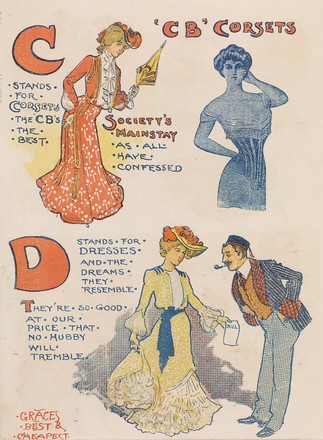In 2011,
the State Library purchased a rare early 20th-century example of Australian
advertising ephemera produced for the well-known, but now defunct, Sydney
retailer Grace Bros.
Grace’s ABC For All Of Us appears, at
first glance, to be a charming alphabet picture book for children, containing
26 quirky rhyming couplets paired with gorgeous Edwardian-style colour
illustrations. Closer examination reveals a strange contradiction between the
‘look-and-feel’ of the ABC booklet and its thinly-veiled advertising content.
With its subject matter and explicit advertorial messages clearly targeted to
the adult reader, there was probably little of actual interest to a child this
small promotional pamphlet. It was cryptic puzzle waiting to be cracked.
An opportunity presented itself when University of Sydney MA student Natalia
Bragaru selected Grace’s ABC as the
subject of her research project for Dr Anita Callaway’s postgraduate seminar
course ‘Backstage at the Mitchell Library’.
Devising and conducting her investigation using the print and
digital resources of the State Library, Natalia swiftly placed the booklet in
the context of its production. Trawling the Trove digitised newspaper archive,
she located advertisements for a Christmas letter-writing competition conducted
by Grace Bros in December 1904.
First established in 1885, Grace Bros had benefited
enormously from the influx of customers carried along George Street by trams
travelling westward to the suburbs after 1882. By July 1904, the retailers had
opened their self-proclaimed ‘Model Store’: a brand new, four-storey, ‘state of
the art’ premises on the corner of George and Bay Streets at Broadway.
To capitalise on the Christmas shopping season, Grace Bros
devised a ‘Letter to Santa’ competition. Their carefully planned marketing
strategy was designed to encourage children and their parents to visit the new
department store. Readers were reminded that Santa Claus was ‘staying at the
Model Store this year’, and that the letter box was located in the toy
department. Santa also promised to send each child ‘one of my A.B.C. Books ...
the funniest books you ever saw’, offering two silver watches as prizes for the
best boy and girl letter writers.
Further inspection of the ABC booklet’s pages confirms its
seasonality and date: Santa is depicted on Grace Bros’ roof on the letter ‘X’
page, while the graphic and verse at the letter ‘J’ carry an explicit reference
to the Russo-Japanese War (1904–05). Closer to Christmas Eve, more messages ‘To
the Little Ones’ reported that thousands of letters had been received, and the
ABC books were nearly all gone. By January, 5,760 letters had been submitted.
The boy winner was decided (Horace Leslie Stock, of Eulah Creek near Narrabri),
but the girl winner had been too close to judge, so the five young lady
finalists would need to be interviewed by Santa, to determine who would receive
the watch.
Another intriguing aspect of Natalia’s research project
required her to attempt to verify the vendor’s suggested attribution of Grace’s ABC as the work of celebrated
illustrator and artist, Norman Lindsay. Through careful comparisons of graphic
details from Grace’s ABC with
original Lindsay illustrations, varying editions of his publications and
contributions to the Bulletin
newspaper, Natalia was able to make a strong case to support this attribution.



 Back to list
Back to list